(Apologies for the repost ... testing out Blogger 2.0's new Labels feature)
Physics and Beyond by Werner Heisenberg
An amazingly human book about physics. In deeply personal terms, Heisenberg tells how he grew from a war-tossed youth to an elder statesman of physics. His thesis is that physics is more than just experiments, numbers and math; instead, it is a deeply social process of discussion among physicists trying to understand the world experiment reveals around them. He weaves an idyllic picture of the interchange among the physicists of his generation, portraying the quantum mechanics as emerging not from dry scientific discussions but from vigorous literary, philosophical and religious interchanges, shared excitement and brassy poker games, and invigorating hiking, mountain climing and sailing adventures. Heisenberg carefully picks out key conversations during his life that ultimately led to the Uncertainty Principle that bears his name, interwoven with key turns of events that illuminate the slow disintegration of Germany leading up to World War II. We watch the idealistic, musical Youth Movement of his childhood degenerate into an edgy conversation with a Hitler Youth member who overhears Heisenberg playing. We see his despair as he is conscripted into the atomic bomb program and tries to steer it towards nuclear piles, rather than nuclear bombs. And we follow him through harrowing bike rides through the lines, the rescue of an old man from a burning house, the shock of an avalanche and an encounter with an unexpectedly friendly American bear.
Truly an amazing book.
Posts published in “Uncategorized”
So my lovely wife Sandi and I often take walks at night, which causes a problem when we've let the cats out. Caesar (our smaller Holstein-cow fraidy cat) and Nero (our larger black-with-white-blaze surly cat) like going O-U-T-S-I-D-E, but if we're walking they tend to follow us, which is dangerous in a neighborhood full of dogs.
SO one night this week we let the cats out the back door, hoping that the normal "beg to be let out back, prowl the back yard, walk the fence, prowl the front yard, beg to be let in front, beg for some C-A-N food, beg to be let out back, repeat" cycle would spin in our favor. No such luck: we were no more than two houses down when Nero leapt out of a bush and began stalking us.
He's done it before, and we've tried to let him follow us before, only to have to pick him up and carry him back when a dog owner turned a corner ahead of us. But we decided to chance it, taking a shortcut that curved round the block back to our house rather than our long route, hoping that at the end of the walk he would want some I-N-S-I-D-E.
Hoping to keep him close, we called Nero, and surprisingly, he came, speeding up to walk with us, sometimes booking it forward to weave between our feet, some times hanging back and playing it cool, never more than twenty feet behind. We made it to the end of the street, then the charming walkway, and then the back side of the street, all with no problems, even when we passed houses that we knew housed dogs.
And then we turned the corner onto our cross street, and saw, crossing right at the intersection leading to our home, a woman with a huge Great Dane. It came to her ribs, head as large as Nero, and she walked right up to the bushes in front of our neighbor's house to let him sniff.
Hoping to pick him up, we called Nero, and thankfully, he stopped, allowing Sandi to pick him up while I calmed him. After a moment I crossed the street to get a better angle, and saw that the lady had taken the Great Dane up our street and out of view. Relieved, we put Nero down and hoped to hurry back to our home, and he booked forward as well, no doubt thinking the same thing.
Then the Great Dane lady returned, having immediately doubled back.
Hoping to avert catastrophe, we told Nero to stop, as if he could understand us, and shockingly, HE DID. We walked up next to him, and he just stood there, looking down the street as the Great Dane looked back at him, never moving while Dane's owner looked at us in acknowledgement and took her charge down the cross street, away from us and out of view with finality.
So we resumed. Nero followed us, weaving through our feet as we turned the same corner where the Great Dane had just stood. We were both shocked. I was raised to believe that you could never herd cats, and yet we had; Sandi, with far more cat experience, pointed out we would have been lucky to get that behavior from a trained dog, much less a new adoptive cat with a rough past, who strolled right up to our front door and darted in quickly without letting his brother out, allowing us to resume our walk.
And that made me think: despite his difficult past and surly demeanor, Nero IS a really good cat, calm and agreeable, easy to pick up, even calm at the vet. Caesar, while skittish, is similarly easy to deal with. Frankly, I don't know how we lucked out. But we did.
Thanks again, God!
-the Centaur
SO one night this week we let the cats out the back door, hoping that the normal "beg to be let out back, prowl the back yard, walk the fence, prowl the front yard, beg to be let in front, beg for some C-A-N food, beg to be let out back, repeat" cycle would spin in our favor. No such luck: we were no more than two houses down when Nero leapt out of a bush and began stalking us.
He's done it before, and we've tried to let him follow us before, only to have to pick him up and carry him back when a dog owner turned a corner ahead of us. But we decided to chance it, taking a shortcut that curved round the block back to our house rather than our long route, hoping that at the end of the walk he would want some I-N-S-I-D-E.
Hoping to keep him close, we called Nero, and surprisingly, he came, speeding up to walk with us, sometimes booking it forward to weave between our feet, some times hanging back and playing it cool, never more than twenty feet behind. We made it to the end of the street, then the charming walkway, and then the back side of the street, all with no problems, even when we passed houses that we knew housed dogs.
And then we turned the corner onto our cross street, and saw, crossing right at the intersection leading to our home, a woman with a huge Great Dane. It came to her ribs, head as large as Nero, and she walked right up to the bushes in front of our neighbor's house to let him sniff.
Hoping to pick him up, we called Nero, and thankfully, he stopped, allowing Sandi to pick him up while I calmed him. After a moment I crossed the street to get a better angle, and saw that the lady had taken the Great Dane up our street and out of view. Relieved, we put Nero down and hoped to hurry back to our home, and he booked forward as well, no doubt thinking the same thing.
Then the Great Dane lady returned, having immediately doubled back.
Hoping to avert catastrophe, we told Nero to stop, as if he could understand us, and shockingly, HE DID. We walked up next to him, and he just stood there, looking down the street as the Great Dane looked back at him, never moving while Dane's owner looked at us in acknowledgement and took her charge down the cross street, away from us and out of view with finality.
So we resumed. Nero followed us, weaving through our feet as we turned the same corner where the Great Dane had just stood. We were both shocked. I was raised to believe that you could never herd cats, and yet we had; Sandi, with far more cat experience, pointed out we would have been lucky to get that behavior from a trained dog, much less a new adoptive cat with a rough past, who strolled right up to our front door and darted in quickly without letting his brother out, allowing us to resume our walk.
And that made me think: despite his difficult past and surly demeanor, Nero IS a really good cat, calm and agreeable, easy to pick up, even calm at the vet. Caesar, while skittish, is similarly easy to deal with. Frankly, I don't know how we lucked out. But we did.
Thanks again, God!
-the Centaur
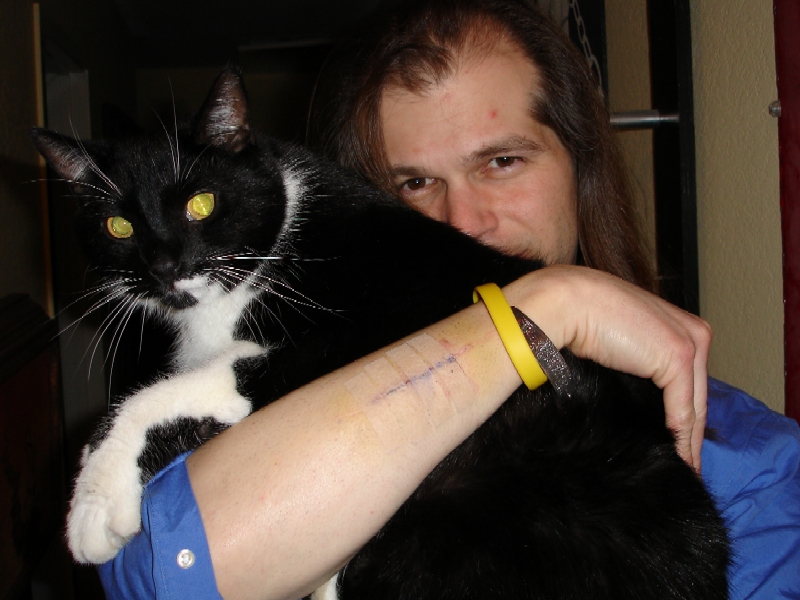
A little over two years ago, I broke my arm in a karate match...

... and received a metal plate in my arm.
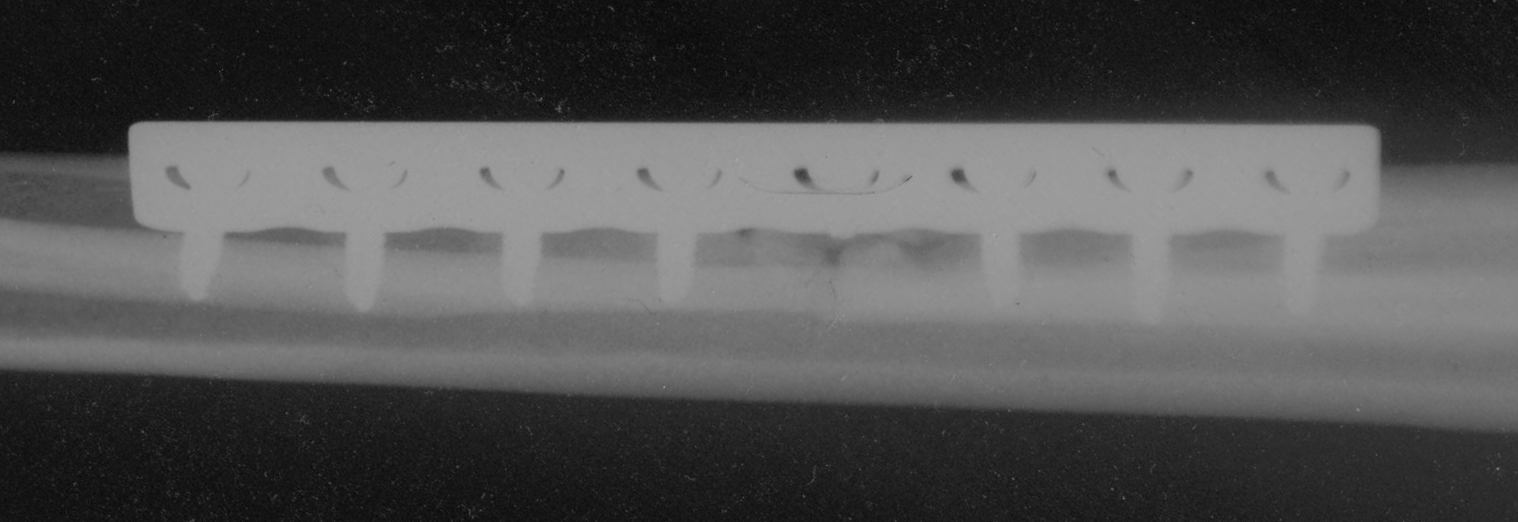
A little over six months later they decided that the bone wasn't healing.

SO, a little under two weeks ago, I went under the knife to have a bone graft to repair my unhealed arm.
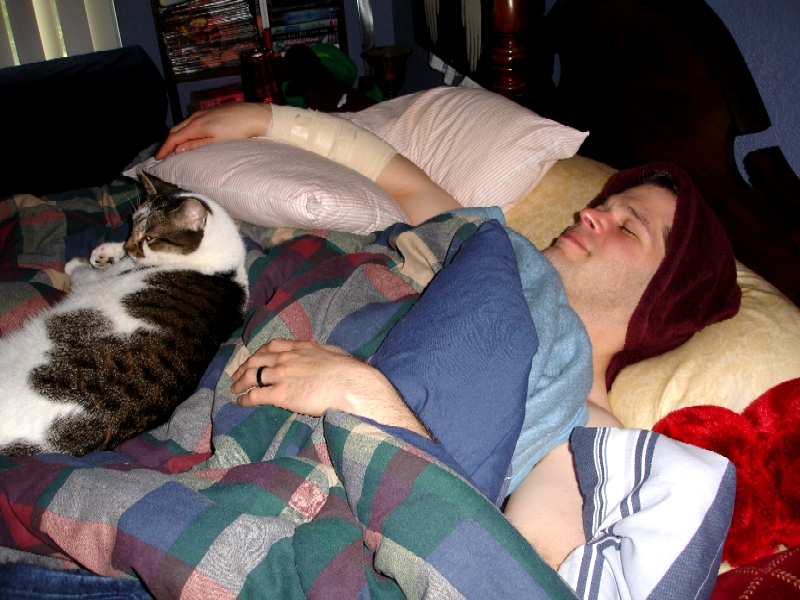
A little under six days later I decided to ask for a blessing from the local priest at the end of mass, as is the custom at our church.
The bandages came off yesterday, and the doctor pronounced me healed. Not a little bit better, not improving, not ready to go in three months as expected or six months if they had to replate it, but healed. Apparently my Atlanta doctor had used a suture to hold a chip of bone in place during the healing process; over time the suture began to dig into the healing bone, clouding up the X-rays and leaving a gap in the CAT scan and overall creating the impression that my arm was much more messed up than it was. My California doctor found the suture, removed it, and probed the bone repeatedly with a scapel to confirm its solidity: as far as he can tell the bone is solid and ready to go.
No replating. No bone graft. Not even a waiting period. Just completely healed.
Now, I'm somewhat skeptical about miracles, which is to say, I'm somewhat a believer too. I of course understand that this is a broken bone that healed, which happens every day, and I have of course heard the old saw that miracles are in the eye of the beholder: to a believer, a sequence of events is credited to God as a miracle; to an unbeliever, that sequence explains the event away. I might complain that that old saw is nonsense, that it presumes there are no supernatural miracles that contravene known natural law like raising the dead, and presumes an ad-hoc explanation after the fact should be considered just as "scientific" as a predictive model developed before the data rolled in. But deep down I know it is just a broken bone after all, which happens every day.
But science or blessing or both, one thing I do know is, I'm grateful about how it turned out. Thanks to all the efforts of my doctors, the support of my wife, the prayers of my friends, and most of all...

...Thanks, God.
-the Centaur
Well, after more than two years since my initial break, I finally bit the bullet and went back under the knife, and am now recuperating:

Ever since we found out my broken arm wasn't healing on schedule, my doctors and I have been playing a waiting game, trying every noninvasive technique we could to spark healing. To no avail; a disgusting lack of progress indeed.
Well, wait no more: the docs opened me up, cleaned up the site where the bone wasn't healing, and closed me up again. Hopefully this will help. Time will tell, as will future X-rays:

More news as it happens. Flash.
-the Centaur

Ever since we found out my broken arm wasn't healing on schedule, my doctors and I have been playing a waiting game, trying every noninvasive technique we could to spark healing. To no avail; a disgusting lack of progress indeed.
Well, wait no more: the docs opened me up, cleaned up the site where the bone wasn't healing, and closed me up again. Hopefully this will help. Time will tell, as will future X-rays:

More news as it happens. Flash.
-the Centaur
Recently at my writing group someone mentioned they were having a lot of difficulty translating their story notes into an outline and asked for help. As we started talking to him, we found out that he'd bought a beautiful, expensive notebook into which he planned to write his thoughts, as soon as his thoughts were together. The advice of the group coordinator could be summed up as: "Get rid of your pretty notebook that you're afraid to write in, because it's getting in the way. Buy a cheap yellow legal pad and WRITE."
SO, what I've found? As cheap and disposable as blog entries are, they're still aimed towards recording complete thoughts. If you can't finish a thought, or it needs to be refined, blogging (for me) gets in the way, because my thoughts drift backward into the distance and I never finish them.
THAT is why I've reinitialized the wiki over at dresan.net. A wiki's pages are automagically editable and suitable for recording incomplete, incoherent, half-completed thoughts that can be edited, updated, or reorganized as need be. My blog was becoming my pristine notebook; so time to whip out something sloppy that I can just write on, regardless of how well formed my thoughts are.
So, for example, when I'm trying to get SLIME working for XEmacs on Windows with CLISP running on Cygwin, and I haven't quite figured it out yet, I can just create a wiki entry on dresan.net about Slime which captures my current thoughts, crossreferenced with XEmacs and CLISP and Cygwin which I can edit and refine to my heart's content.
If there's an easy way to do that on a traditional blog, I don't know it yet. But I can make a wiki proxy a blog: see the updates page of dresan.net for a good example.
Not that I want to give up blogging in favor of futzing around on a wiki; there's something deeply satisfying about this blog and its interface. But I do miss my wiki features on the blog, and I hope that one day either Blogger adapts those features or else that I find a wiki/blog/bliki that does the job that I can port all my old data from.
Blog/Wiki developers, take note.
-the Centaur
SO, what I've found? As cheap and disposable as blog entries are, they're still aimed towards recording complete thoughts. If you can't finish a thought, or it needs to be refined, blogging (for me) gets in the way, because my thoughts drift backward into the distance and I never finish them.
THAT is why I've reinitialized the wiki over at dresan.net. A wiki's pages are automagically editable and suitable for recording incomplete, incoherent, half-completed thoughts that can be edited, updated, or reorganized as need be. My blog was becoming my pristine notebook; so time to whip out something sloppy that I can just write on, regardless of how well formed my thoughts are.
So, for example, when I'm trying to get SLIME working for XEmacs on Windows with CLISP running on Cygwin, and I haven't quite figured it out yet, I can just create a wiki entry on dresan.net about Slime which captures my current thoughts, crossreferenced with XEmacs and CLISP and Cygwin which I can edit and refine to my heart's content.
If there's an easy way to do that on a traditional blog, I don't know it yet. But I can make a wiki proxy a blog: see the updates page of dresan.net for a good example.
Not that I want to give up blogging in favor of futzing around on a wiki; there's something deeply satisfying about this blog and its interface. But I do miss my wiki features on the blog, and I hope that one day either Blogger adapts those features or else that I find a wiki/blog/bliki that does the job that I can port all my old data from.
Blog/Wiki developers, take note.
-the Centaur
Telling a story in six words? Unbelievable, until you see the evidence! Over on Wired:
Very Short Stories. Writers needing exercises, try it out!
-the Centaur
P.S. Technically I realize that the above is an essay told in six-word sentences, not four separate six-word stories, but then many of the "stories" over on Wired are really haiku-like phrases that set a scene. So sue me.
Very Short Stories. Writers needing exercises, try it out!
-the Centaur
P.S. Technically I realize that the above is an essay told in six-word sentences, not four separate six-word stories, but then many of the "stories" over on Wired are really haiku-like phrases that set a scene. So sue me.
Over on our sister site www.dresan.net, I've added a wiki, a blog, and some forums. For an explanation of why, check out Why Dresan.Net? over on the dresan.net blog.
The short story is that the Library of Dresan will remain my primary blog, but I've created dresan.net as a playground to experiment with new technologies. It's still a little rough, but I hope to beat it into shape over the next few weeks.
So enjoy!
-the Centaur
The short story is that the Library of Dresan will remain my primary blog, but I've created dresan.net as a playground to experiment with new technologies. It's still a little rough, but I hope to beat it into shape over the next few weeks.
So enjoy!
-the Centaur
Once again, I am behind the technology curve. Google Reader provides a convenient interface to a whole bunch of RSS feeds with a much more convenient interface than my other RSS readers - plus it has a neat "scrolling down counts a message as read unless you tell me otherwise" feature which makes it easy to keep up with new articles just by scrolling through whatever's new every time you look at it. Like Google Bookmarks (available if you log in) and Google Notebook (available through the Google Labs page) all these "always-on" services are changing my view of the Web.
Except of course I still can't get internet at home, dag nab it, since I live on the surface of Mars, which does put a kink in the whole thing (hence my nickname "Internet Cafe Boy"). Oh well. I pray that state of affairs won't last forever.
-Anthony
Except of course I still can't get internet at home, dag nab it, since I live on the surface of Mars, which does put a kink in the whole thing (hence my nickname "Internet Cafe Boy"). Oh well. I pray that state of affairs won't last forever.
-Anthony
Mother of Mercy. I was digging through my old posts and found this unpublished, unfinished draft started on October 4, 2006 titled "pacman???". Apparently I stumbled across version of Pacman written in Excel and was so shocked that I could only write the outline of the post in a barely organized list of URLs.
Reading through those ... apparently my initial horror led me to look into a whole bunch of other things, including the Javascript Arcade with versions of classic games written in Javascript. Back then, people were looking at using a variety of DHTML tricks to do graphics in Javascript. In the days of Chrome Experiments, a few short years later, this no longer seems insane, though now you're more likely to want to do this in Flash ... and sure enough someone has done so.
Reading through the tiny notes and trying to reconstruct my thought process ... apparently the idea of using Excel to implement Pac Man, and the challenges of drawing lines in the DOM, took me back to the ideas of in Fundamentals of Interactive Computer Graphics, Jim Foley's text, the first book I learned graphics from. There have been many versions of that book since, but they'll all tell you how to create lines on a grid, whether you're doing it with low-level hardware or with cells in Excel ... shudder.
Apparently creating graphics on top of a windowing system and browser reminded me of the idea of virtual machines, a fundamental idea in computer science in which one computer system can be used as the "physical hardware" to create another computer system on top of it. Once you create one virtual machine, it can then be used to create another ... and another, and another. Another "seminal" book for me, Douglas Hofstadter's Godel Escher Bach, explores the consequences of layers of virtual machines in much creative detail.
So the point being, the more advanced our computers become, the more likely it is that we'll be creating things like Pac Man in Excel.
I don't know whether to weep in joy or fear.
-the Centaur
Reading through those ... apparently my initial horror led me to look into a whole bunch of other things, including the Javascript Arcade with versions of classic games written in Javascript. Back then, people were looking at using a variety of DHTML tricks to do graphics in Javascript. In the days of Chrome Experiments, a few short years later, this no longer seems insane, though now you're more likely to want to do this in Flash ... and sure enough someone has done so.
Reading through the tiny notes and trying to reconstruct my thought process ... apparently the idea of using Excel to implement Pac Man, and the challenges of drawing lines in the DOM, took me back to the ideas of in Fundamentals of Interactive Computer Graphics, Jim Foley's text, the first book I learned graphics from. There have been many versions of that book since, but they'll all tell you how to create lines on a grid, whether you're doing it with low-level hardware or with cells in Excel ... shudder.
Apparently creating graphics on top of a windowing system and browser reminded me of the idea of virtual machines, a fundamental idea in computer science in which one computer system can be used as the "physical hardware" to create another computer system on top of it. Once you create one virtual machine, it can then be used to create another ... and another, and another. Another "seminal" book for me, Douglas Hofstadter's Godel Escher Bach, explores the consequences of layers of virtual machines in much creative detail.
So the point being, the more advanced our computers become, the more likely it is that we'll be creating things like Pac Man in Excel.
I don't know whether to weep in joy or fear.
-the Centaur
I loves me that woman, Sandi Billingsley. We be married now:

And I love our groomsmen and bridesmaids and all of our friends who dressed up, the good sports that they are:
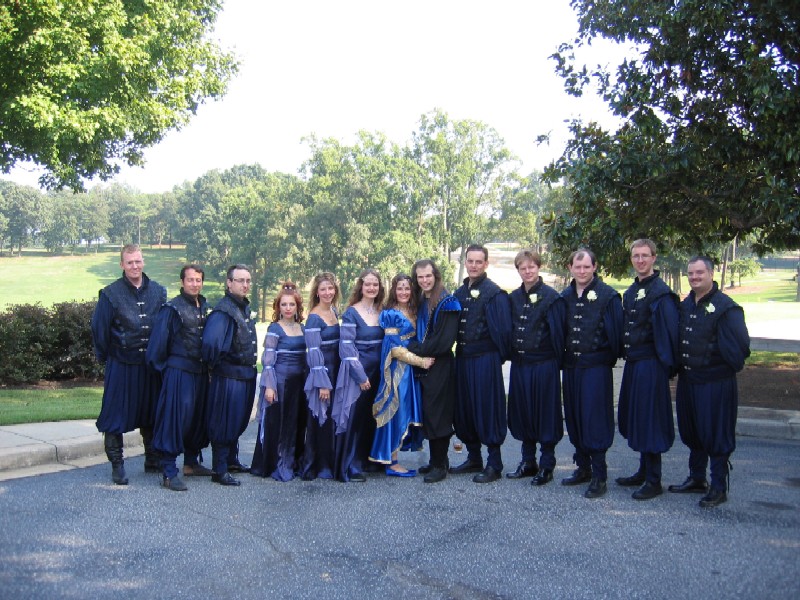
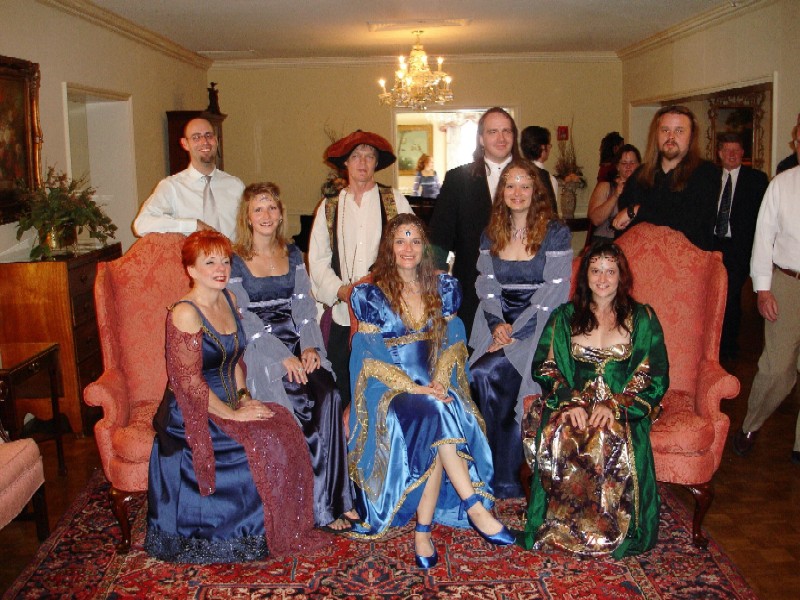
Double props to my groomsmen, who were sharp as tacks in their gear and didn't give me too much grief me for pushing them so far out of their circles:

I also love Mom and deeply appreciate her organizing most of the wedding, and I love the Francis family and the Billingsleys and would showcase them too if the pictures had come in yet (soon!)
But I love most her:

Here's to you, Sandi.
-your Centaur

And I love our groomsmen and bridesmaids and all of our friends who dressed up, the good sports that they are:


Double props to my groomsmen, who were sharp as tacks in their gear and didn't give me too much grief me for pushing them so far out of their circles:

I also love Mom and deeply appreciate her organizing most of the wedding, and I love the Francis family and the Billingsleys and would showcase them too if the pictures had come in yet (soon!)
But I love most her:

Here's to you, Sandi.
-your Centaur
... moderation of comments is now ON, spamfiends.
-the Centaur
-the Centaur
Recently as both a followon to my thesis research and as a part of my work for the Search Engine That Starts With A G, I've been investigating a number of papers on graph theory as applied to semantic networks and Web link graphs. This work isn't "new" per se, since these models and techniques for graph analysis go back years if not decades, but it's only recently - when vast real-world networks have become available in machine-readable form along with the computer power necessary to analyze them - that enough work has been done to illuminate how important it is to analyze the properties of networks in detail.
One of the most interesting papers I've encountered so far was The Structure and Function of Complex Networks, a survey of mathematical and empirical studies of networks that I had wish had been available when I was doing my thesis work. The most important result I think to come out of recent graph theory is that simple uniform and random models of networks don't tell the whole story - now, we have new mathematical tools for modeling a wide range of graph architectures, such as:
There are more issues in graph theory than I can readily summarize, including issues like resilience to deletion, models of growth, and so on; many of which are directly relevant to studies of semantic networks and processes that operate over them.
Another paper, The Large-Scale Structure of Semantic Networks, applies these techniques to real-world semantic network models drawn from sources such as WordNet and Roget's Thesaurus. This paper, like the survey article Graph Theoretic Modeling of Large Scale Semantic Networks, seems to find that real semantic networks have scale-free, small-world properties that aren't found in the simpler mathematical models that people such as Francis (cough) used in his thesis.
SO, anyone interested in semantic networks or spreading activation as a tool for modeling human cognition or as a representation scheme for an intelligent system would do well to follow up on these references and begin an analysis of their systems based on these "new" techniques (many of which have been around for a while, but sadly hadn't reached everyone in the semantic network community (or, at least, hadn't reached me) until more recently.
So check them out!
-the Centaur
One of the most interesting papers I've encountered so far was The Structure and Function of Complex Networks, a survey of mathematical and empirical studies of networks that I had wish had been available when I was doing my thesis work. The most important result I think to come out of recent graph theory is that simple uniform and random models of networks don't tell the whole story - now, we have new mathematical tools for modeling a wide range of graph architectures, such as:
- Small World Networks. A traditional graph model says nothing about how far you may need to travel to find an arbitrary node in the graph. Think of square tiles on a floor - each tile is connected to four others, but the number of steps needed to reach any tile is a function of the distance. But anyone who's played the parlor game "Six Degrees of Kevin Bacon" knows that real-world human relationships aren't arranged this way: everyone is connected to everyone else in the world by a very short chain of relationships - on average, you can reach almost anyone in the world in only six or seven handshakes. This shows up in graph analysis as the "mean geodesic distance" between two nodes in a graph, and is an important property we should measure about our networks as they grow to determine what kind of network structure we are really dealing with. At the very least, a random graph structure shows small-world properties more similar to real-world graphs than uniform graphs, and we should consider using them over uniform models as a basis for analyses.
- Scale-Free Networks. Both uniform networks - where every node has the same link structure - and random networks - where nodes are connected at random to each other across the graph - have a definite scale or rough average size. Nodes in a random graph are like people: each one is unique, but their heights are distributed over a defnite scale so there are few people shorter than three feet and no people taller than nine. Real world networks don't have this definite scale: instead, they look the "same" no matter what size scale you're looking at. Nodes in a real world graph are like the distribution of city sizes: for every city there are four times as many cities at half that size. This shows up technically in the "degree distribution": the statistical pattern of the number of links on each node. This will no doubt have significant effects on processes operating over networks like spreading activation.
There are more issues in graph theory than I can readily summarize, including issues like resilience to deletion, models of growth, and so on; many of which are directly relevant to studies of semantic networks and processes that operate over them.
Another paper, The Large-Scale Structure of Semantic Networks, applies these techniques to real-world semantic network models drawn from sources such as WordNet and Roget's Thesaurus. This paper, like the survey article Graph Theoretic Modeling of Large Scale Semantic Networks, seems to find that real semantic networks have scale-free, small-world properties that aren't found in the simpler mathematical models that people such as Francis (cough) used in his thesis.
SO, anyone interested in semantic networks or spreading activation as a tool for modeling human cognition or as a representation scheme for an intelligent system would do well to follow up on these references and begin an analysis of their systems based on these "new" techniques (many of which have been around for a while, but sadly hadn't reached everyone in the semantic network community (or, at least, hadn't reached me) until more recently.
So check them out!
-the Centaur
...just think of:

Bwah ha ha! Inspirational posters a la Star Trek, already familiar to anyone who reads Slashdot, of course...

Bwah ha ha! Inspirational posters a la Star Trek, already familiar to anyone who reads Slashdot, of course...
I've been a part of the "Dragonwriters" writing group since 2002, when a group of people who attended Ann Crispin's Dragon*Con writing class decided that they wanted to stay in touch ... and did. We eventually came up with a slogan for our group ... "Dragonwriters: Torturing Our Characters for Your Pleasure" based on the idea that authors should put their characters through the wringer in order to create interesting stories. Well, now we have a t-shirt based on this idea:

Enjoy!
-the Centaur

Enjoy!
-the Centaur
I was going to start this article by tossing up a shout out to taidoblog, andy fossett's in-depth analysis of taido, but it then occurred to me that taidoblog is only the most recent of a whole category of blogs and articles that I've only recently started to notice, and even more recently started to truly admire: people who can actually think.
The object of inquiry of andy fossett's taidoblog is taido, his (and my) chosen martial art. This alone would capture my interest, but what's always struck me is not just andy's subject, but his method. He puts deep thought into his chosen interest: he maps out the landscape of practice, critically evaluates existing opinions, formulates radical new ideas, and puts them all to the test. He's not afraid to boldly throw out bad traditions OR to slavishly follow traditions that work, at least until he has learned all he can and/or developed something better.
Big Jimmy Style is the platform of Jim Davies, a similar investigator whose chosen interest is research and science. He and I don't see eye to eye in areas like healthy eating, environmentalism and voting, but I don't personally know anyone who puts deeper thought into artificial intelligence and cognitive science research - what it is, why it's important, how it should be done, and what it's goals are. Jim regularly holds my feet to the fire in our private correspondence, and in his blog he continues the tradition of calling bullshit when he sees it and constructing frameworks that help him tackle hard problems.
The strength of Gordon Shippey's Vast and Infinite comes from his clear personal philosophy, strong scientific training and strength of character. While at this instant his blog is suffering from Movable Type's "I'm busy this month" whitescreen, Vast and Infinite is the sounding board for G'hrdun's ongoing exploration of what works in the work place, a topic of deep personal interest that he explores from a clear objectivist ethical perspective informed by his psychological knowledge, scientific training and personal experience. If you watch long enough you'll also see scientific/libertarian analysis of modern political and scientific developments.
Scott Cole's The Visual Writer has always been overwhelming to me: there are more ideas bouncing around on his site than I've ever been able to mine. For a long time I read his articles on the theory of writing stories but his philosophical articles are just as interesting. While there are some areas he and I might disagree on particular points, on the majority of writing topics he's explored more issues that I was even aware existed.
And then of course, there's Richard Feynman's blog The Smartest Man In the World. Actually, it's not, and he disliked that title, but we can only wish Feynman hadn't died before blogs came to being. In lieu of that, I can recommend The Pleasure of Finding Things Out, which, despite some people's complaints that it rehashes his other books, does a good job of putting in one place Feynman's essential thoughts about the scientific method, the importance of integrity, the difficulty of not fooling yourself.
The point of me mentioning all these people is that they're good examples of people who are thinking. They aren't just interested in things; they're actually cataloguing what they see, organizing it, judging it, evaluating it; deciding what they want to do with it and formulating opinions on it. In andy's writings in particular he goes further: he's not willing to settle just for opinions, but must go test it out to find out whether he's are full of shit or not. And at the highest level, Feynman integrates challenging his own ideas and reporting the results of his challenges into the very core of the his being - because he who sees the deepest is the man who stops to clean his lens.
That's what I want to be when I grow up.
So go check 'em out.
Because everything is interesting if you dig deeply enough.
-the Centaur
The object of inquiry of andy fossett's taidoblog is taido, his (and my) chosen martial art. This alone would capture my interest, but what's always struck me is not just andy's subject, but his method. He puts deep thought into his chosen interest: he maps out the landscape of practice, critically evaluates existing opinions, formulates radical new ideas, and puts them all to the test. He's not afraid to boldly throw out bad traditions OR to slavishly follow traditions that work, at least until he has learned all he can and/or developed something better.
Big Jimmy Style is the platform of Jim Davies, a similar investigator whose chosen interest is research and science. He and I don't see eye to eye in areas like healthy eating, environmentalism and voting, but I don't personally know anyone who puts deeper thought into artificial intelligence and cognitive science research - what it is, why it's important, how it should be done, and what it's goals are. Jim regularly holds my feet to the fire in our private correspondence, and in his blog he continues the tradition of calling bullshit when he sees it and constructing frameworks that help him tackle hard problems.
The strength of Gordon Shippey's Vast and Infinite comes from his clear personal philosophy, strong scientific training and strength of character. While at this instant his blog is suffering from Movable Type's "I'm busy this month" whitescreen, Vast and Infinite is the sounding board for G'hrdun's ongoing exploration of what works in the work place, a topic of deep personal interest that he explores from a clear objectivist ethical perspective informed by his psychological knowledge, scientific training and personal experience. If you watch long enough you'll also see scientific/libertarian analysis of modern political and scientific developments.
Scott Cole's The Visual Writer has always been overwhelming to me: there are more ideas bouncing around on his site than I've ever been able to mine. For a long time I read his articles on the theory of writing stories but his philosophical articles are just as interesting. While there are some areas he and I might disagree on particular points, on the majority of writing topics he's explored more issues that I was even aware existed.
And then of course, there's Richard Feynman's blog The Smartest Man In the World. Actually, it's not, and he disliked that title, but we can only wish Feynman hadn't died before blogs came to being. In lieu of that, I can recommend The Pleasure of Finding Things Out, which, despite some people's complaints that it rehashes his other books, does a good job of putting in one place Feynman's essential thoughts about the scientific method, the importance of integrity, the difficulty of not fooling yourself.
The point of me mentioning all these people is that they're good examples of people who are thinking. They aren't just interested in things; they're actually cataloguing what they see, organizing it, judging it, evaluating it; deciding what they want to do with it and formulating opinions on it. In andy's writings in particular he goes further: he's not willing to settle just for opinions, but must go test it out to find out whether he's are full of shit or not. And at the highest level, Feynman integrates challenging his own ideas and reporting the results of his challenges into the very core of the his being - because he who sees the deepest is the man who stops to clean his lens.
That's what I want to be when I grow up.
So go check 'em out.
Because everything is interesting if you dig deeply enough.
-the Centaur
A shout out to Scott Cole and his always interesting Visual Writer site, which is more comprehensive than I could possibly describe in a few short paragraphs. If you're at all interested in improving your writing, the philosophy of words, or the philosophy of the human condition, you should check it out.
hEY! Check out Riva.com: they claim you can search for people in photos by face recognition, and this is what I get for "President Clinton":
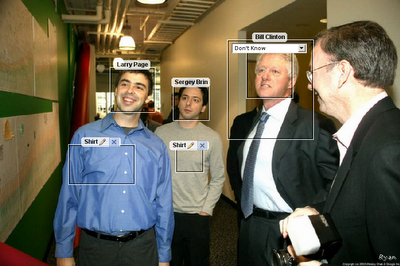
More obscure people are harder to find, so it's not clear how well the software works overall.
But still! Minority Report, here we come.
-the Centaur

More obscure people are harder to find, so it's not clear how well the software works overall.
But still! Minority Report, here we come.
-the Centaur
Why did I not do this earlier? Flickr.
SO as many of you may know I'm a big fan of coffeehouses and sandwich shops: they're quiet places where you can chill out, have a nice meal, focus on your book, and, if wifi-enabled, whip together a decent blog entry with free refills on your soda.

And my favorite of all sandwich places? A tight, long-running contest between Panera Bread (nee Saint Louis Bread Company) and Atlanta Bread Company (especially the one near Perimeter Mall in Atlanta).
Now, I've been eating and reading since I was a kid, but my love of sandwich shops I think really started with Le Boulanger in Menlo Park during my internship at SRI. Since then, however, Atlanta Bread Company and Panera Bread became my favorites because of their high quality, good portions, salad/sandwich combos, nutrition information available online, and good iced tea.
But it may take a while before Atlanta Bread Company comes to California, and as part of the Big Adjustment I've been looking for a replacement. Up till now I've had little luck - the sandwiches at the search engine that begins with a G are good but not Panera-grade, and Le Boulanger in Mountain View, while very nice, is somehow not quite the same.
So imagine my delight when I find that a Panera Bread has opened in Cupertino! I found it of course with Google Local, which lets you ask questions like "panera bread near mountain view, california" and get coherent answers, along with a nice map interface that will lead you right to a place like this on Steven's Creek Boulevard in Cupertino:

Cupertino is a bustling town perhaps best known for some fruit company, but its charm for me is that it's roughly midway between my new home with its Olive Tree and my new workplace at The Search Engine that Begins with a G. It's blessed with (normally) temperate weather, which is perhaps why when I first showed up the patio was filled with diners (most of whom had departed by the time I decided to start taking photos).
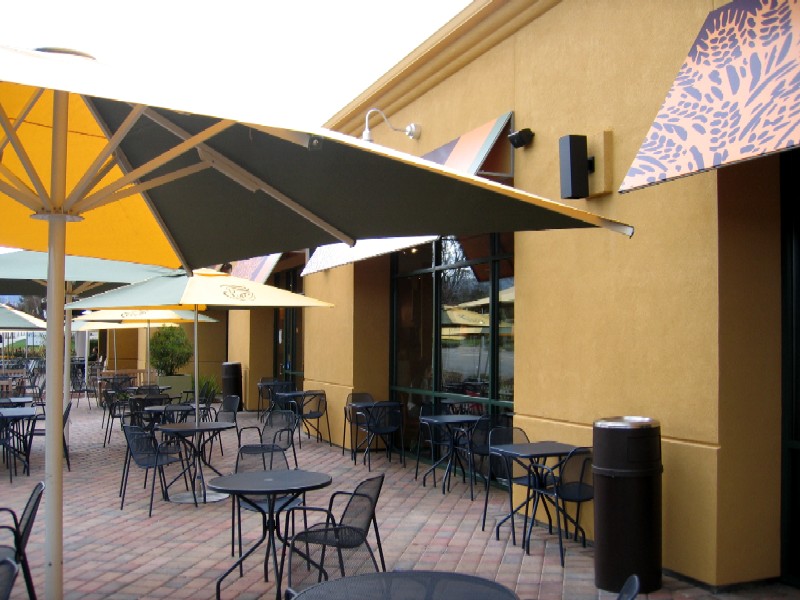
The real delight is inside, however. Panera has a truly staggering selection of breads and pastries, and can assemble these into a wide variety of made-to-order sandwiches and specials that are best topped off with a cinnamon roll that's as asymptotically close to the Platonic Ideal of a cinnamon roll as you're likely to get in this world. (Yes, I read the nutrition info on the cinnamon rolls, and so limit myself to one every other time I go. I enjoy being able to go through the door; this enables me to eat more cinnamon rolls).

So happily I drop in and order my typical Bacon Turkey Bravo / Asian Chicken Salad combo (with cinnamon roll, of course), get my iced tea, noticing some guy who'd ordered the same thing get his meal, and sat down to read a book on C++. SO I'm sitting there, reading, having a good time, getting hungrier and hungrier, and eventually realize "this ain't right". So I head up to the counter and ask, and the manager's face flushed and he said, "I'm so sorry, I think somebody snagged it. We'll make you another one right away." I slapped my forehead - the man I'd seen hadn't picked up a meal identical to mine, but instead in identity, mine. Not their fault - but they made me another sandwich anyway.
And gave me a bag of cookies.
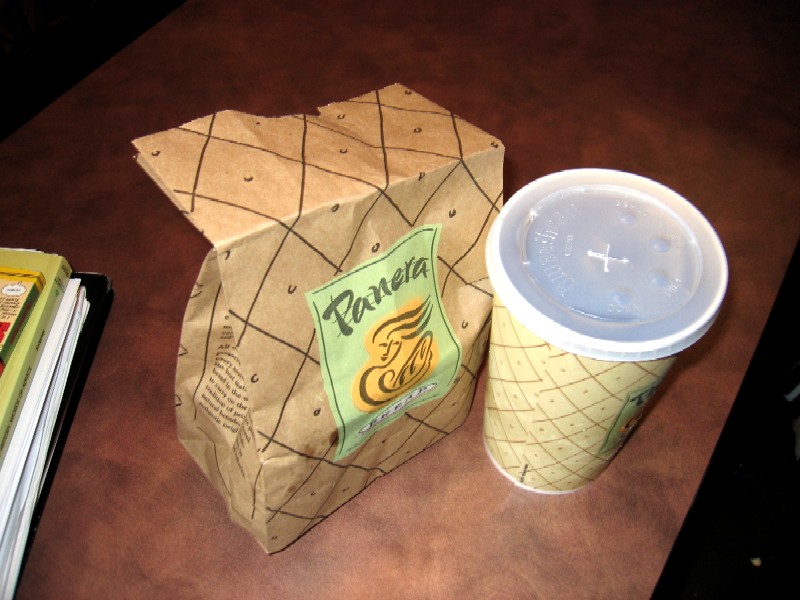
So, Panera Bread rules!
-the Centaur
P.S. Thank you, God; normally you know I don't like to put your name in titles or stuff like that (name in vain and all) but, hey, that was really nice of you to drop one of those off there and you deserve the credit. Thanks!

And my favorite of all sandwich places? A tight, long-running contest between Panera Bread (nee Saint Louis Bread Company) and Atlanta Bread Company (especially the one near Perimeter Mall in Atlanta).
Now, I've been eating and reading since I was a kid, but my love of sandwich shops I think really started with Le Boulanger in Menlo Park during my internship at SRI. Since then, however, Atlanta Bread Company and Panera Bread became my favorites because of their high quality, good portions, salad/sandwich combos, nutrition information available online, and good iced tea.
But it may take a while before Atlanta Bread Company comes to California, and as part of the Big Adjustment I've been looking for a replacement. Up till now I've had little luck - the sandwiches at the search engine that begins with a G are good but not Panera-grade, and Le Boulanger in Mountain View, while very nice, is somehow not quite the same.
So imagine my delight when I find that a Panera Bread has opened in Cupertino! I found it of course with Google Local, which lets you ask questions like "panera bread near mountain view, california" and get coherent answers, along with a nice map interface that will lead you right to a place like this on Steven's Creek Boulevard in Cupertino:

Cupertino is a bustling town perhaps best known for some fruit company, but its charm for me is that it's roughly midway between my new home with its Olive Tree and my new workplace at The Search Engine that Begins with a G. It's blessed with (normally) temperate weather, which is perhaps why when I first showed up the patio was filled with diners (most of whom had departed by the time I decided to start taking photos).

The real delight is inside, however. Panera has a truly staggering selection of breads and pastries, and can assemble these into a wide variety of made-to-order sandwiches and specials that are best topped off with a cinnamon roll that's as asymptotically close to the Platonic Ideal of a cinnamon roll as you're likely to get in this world. (Yes, I read the nutrition info on the cinnamon rolls, and so limit myself to one every other time I go. I enjoy being able to go through the door; this enables me to eat more cinnamon rolls).

So happily I drop in and order my typical Bacon Turkey Bravo / Asian Chicken Salad combo (with cinnamon roll, of course), get my iced tea, noticing some guy who'd ordered the same thing get his meal, and sat down to read a book on C++. SO I'm sitting there, reading, having a good time, getting hungrier and hungrier, and eventually realize "this ain't right". So I head up to the counter and ask, and the manager's face flushed and he said, "I'm so sorry, I think somebody snagged it. We'll make you another one right away." I slapped my forehead - the man I'd seen hadn't picked up a meal identical to mine, but instead in identity, mine. Not their fault - but they made me another sandwich anyway.
And gave me a bag of cookies.

So, Panera Bread rules!
-the Centaur
P.S. Thank you, God; normally you know I don't like to put your name in titles or stuff like that (name in vain and all) but, hey, that was really nice of you to drop one of those off there and you deserve the credit. Thanks!
